| |
Glossary of Coral Reef Terminology - R
Røst Reef - the world's largest known deep-water Lophelia coral complex. It lies in depths between 300-400m west of R+st Island in the Lofoten archipelago, Norway. It covers an area approximately 40 km long and 3 km wide |
race - a distinguishable group of organisms of a particular species that is geographically, ecologically, physiologically, physically, and/or genetically distinct from other members of the species |
race - a population differing from others; refers to a unit below the subspecies level which is not given a taxonomic name |
RACE (Rapid Amplification of cDNA Ends) - a technique used to obtain the 3' and 5' end of a cDNA. The technique involves three sequential enzymatic steps: reverse transcription, addition of homopolymeric tails, and polymerase chain reaction (PCR) |
radial canal - a part of the water vascular system of echinoderms. Specifically, a branch off of the ring canal that leads to an arm (ray) and gives rise to the tube feet. In hydrozoan medusae, the radial canal is part of the gastrovascular cavity. it is one of four extensions leading from the mouth to the outer margin of the bell |

Illustration of radial cell cleavage. (Illustration: BIODIDAC)
|
radial cleavage - a type of cleavage characteristic of deuterostomes. When changing from a four-cell stage to an eight-cell stage embryo, the cells divide such that each cell in the top four cell plane is directly over one other cell in the bottom plane |
radial corallite - a corallite on a side of a branch as opposed to an axial corallite on the tip of the branch |

Radial symmetry, illustrated by this starfish (Echinodermata).
|
radial symmetry - a basic morphological plan of organisms that have their body parts arranged around a central axis. Such organisms tend to be circular or cylindrical in shape, e.g., a coral polyp, or have projections around a central disc, e.g., starfish |
radial velocity - component of motion toward or away from a given location |
radiant energy - energy traveling in the form of electromagnetic waves; energy emitted by the sun, typically in photons and waves |
radiant flux - the rate of flow of radiant energy (electromagnetic waves) |
radiation - energy that comes from a source and travels through some material or through space. Light, heat and sound are types of radiation |
radii - inconspicuous septal elements which connect septa with the columella |
radioactive decay - natural decay of the nucleus of an atom where alpha or beta and/or gamma rays are released at a fixed rate |
radioactive isotope - an unstable isotope of an element that decays or disintegrates spontaneously, emitting radiation |
radioactivity - the spontaneous decay of the nucleus of an element. It involves the change in the number of protons in the nucleus and therefore creates an atom of a new element |
radiocarbon age - the age of plant or animal remains, determined by measuring the remaining activity of the 14C atoms in the sample: A=A0 e-t where A is the measured activity, A0 is the initial activity, e is the decay constant, and t is the sample age |
radiocarbon dating - a dating method used to determine the age of samples containing carbon. The method measures the disintegration of the 14C atom. 14C is produced in the atmosphere by cosmic ray bombardment, and has a half-life of 5,570 years, making it useful for dating samples in the range of 0-40,000 years |
radiocarbon time - regular known rates of radiocarbon decay that are used to determine the exact ages of carbon-based life |
radiometer - an instrument used to measure radiant energy |
radiometer - an instrument for measuring radiation energy |
radiometry - the science of the measurement of radiant energy |
radionuclide - any radioactive isotope |
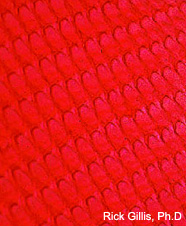
A stained section of a snail radula. The numerous chitinous teeth on this ribbon-like membrane are used to scrape, pierce, tear or cut off small pieces of food that are then directed in a continuous stream toward the digestive tract by conveyor belt like movements of the membrane. (Photo: Rick Gillis, Ph.D., Biology Dept., University of Wisconsin-La Crosse)
|
radula - a scraping organ for mastication in certain mollusks, such as snails. In many gastropods the radula consists of a variable number of chitinous teeth, of different shape and size, located in the anterior portion of the pharynx. In the cone shell family it has been reduced to a sharp and grooved tooth, fit to harpoon and inject prey with a powerful venom, which is also potentially fatal to humans |
rain shadow - an area of reduced precipitation on the wind-sheltered lee side of a mountain range caused by warming of air and dissipation of cloudiness as air descends the mountain barrier |
Raita Bank - one of several submerged banks in the Northwestern Hawaiian Islands. It is a raised area of the ocean floor just 60 feet below the surface |
ramifying - branching, dividing |
rampart - a narrow ridge, 1-2 m high, built by waves along the seaward edge of a reef flat. It consists of boulders, shingle, gravel or reef rubble, commonly capped by dune sand |
random genetic drift - changes in allele frequency that result because the genes appearing in offspring are not a perfectly representative sampling of the parental genes, i.e., changes in allelic frequency due to sampling error |
random sample - a sample in which each individual in a population has the same chance of being selected as any other |
random sampling - a sampling technique where a group of subjects (a sample) is selected for study from a larger group (a population). Each individual is chosen entirely by chance and each member of the population has a known, but possibly non-equal, chance of being included in the sample. By using random sampling, the likelihood of bias is reduced |
range - the range of a set of numbers is the largest value in the set minus the smallest value in the set. It is a single number |
range - the geographical area inhabited by a species or other group; may be continuous or discontinuous |
rank - in taxonomy, the level, for nomenclatural purposes, of a taxon in a taxonomic hierarchy (e.g. all families are for nomenclatural purposes at the same rank, which lies between superfamily and subfamily) |
ranked data - data for which the observations have been replaced by their numerical ranks from lowest to highest |
rapacious - grasping, predatory |
Rapid Ecological Assessment (REA) - a method for gathering data pertaining to ecologically significant biological components of a reef habitat over small spatial scales. Because the method provides a quick “snapshot” of major reef biota during a single dive or snorkel survey, it is particularly useful in assessing remote areas that are only rarely visited and where little time can be spent. REA is usefully employed by Coral Reef Ecosystem Division (CRED) at the NMFS Pacific Island Fisheries Science Center. During research cruises to these remote areas, teams of CRED divers survey the reef communities in a comprehensive manner, recording species abundance, diversity, and spatial distribution simultaneously for four key components of the ecosystem: fishes, corals, other invertebrates, and algae. Specific protocols are followed for field work and subsequent laboratory analyses |
RARE - a U.S.-based conservation organization that works globally to equip people in the world’s most threatened natural areas with the tools and motivation they need to care for their natural resources |
raster - an abstraction of the real world where spatial data is expressed as a matrix of cells or pixels, with spatial position implicit in the ordering of the pixels. With the raster data model, spatial data is not continuous but divided into discrete units. This makes raster data particularly suitable for certain types of spatial operation. The term may also refer to the region of a CRT (cathode-ray tube) or LCD (liquid crystal display) monitor that is capable of rendering images |
raster map - a map or chart encoded in the form of a regular array of cells |
raw sewage - untreated domestic or commercial waste water |
RDBMS (Relational database management system) - a database management system with the ability to access data organized in tabular files that can be related to each other by a common field (item). An RDBMS has the capability to recombine the data items from different files, providing powerful tools for data usage |
reach - an arm of the ocean extending into the land |
reaction time - the duration between the beginning of stimulation and the initiation of a response |
reagent - a compound involved in a chemical or biochemical reaction, especially one used in chemical analysis to produce a characteristic reaction in order to determine the presence of another compound |
real time - time in which reporting of events or recording of events is simultaneous with the event |
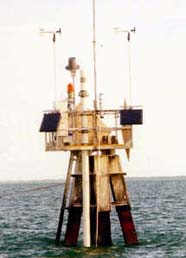
Seakeys stations transmit real-time data. (Photo: NOAA)
|
real-time data - data collected by automated instrumentation and telemetered and analyzed quickly enough to influence a decision that affects the monitored system |
realized niche - that portion of a fundamental niche which is actually occupied by a species |
rearing habitat - an area where larval and juvenile fish find food and shelter |
rebar - short for reinforcing bar. A steel bar, usually with manufactured deformations, used in concrete and masonry construction to provide additional strength. Some in the coral trade question whether rebar may contribute to nutrient loading and therefore promote algal growth as it rusts over a long time period |
rebreather - an underwater breathing apparatus which is the source of breathing gas for scuba divers. A rebreather "recycles" the exhalation gasses by recovering them from the mouthpieced (and not flushing them into the surrounding water). Since not all of the oxygen in an inhalation breath is used, there is always some left in exhalation, and this gas goes through the breathing loop multiple times until it's converted into carbon dioxide. This exhalation is cycled back into the unit, where the exhaled gas is run through a scrubber, removing carbon dioxide by chemical reaction with soda lime. Oxygen is injected into the loop automatically by a computer-controlled solenoid valve in response to information received from oxygen sensors. In this way the inspiration maintains a constant partial pressure of oxygen throughout the dive. Therefore, the diver only consumes the small amount of oxygen that the body actually needs and metabolizes.. The resulting gas is analyzed by sensors to determine oxygen content and if necessary oxygen is added to the mix for the current depth from a small tank carried with the rebreather. Advantages of a rebreather are many. It allows longer bottom times. Since no bubbles are released into the water, stealth for animal behavior studies and underwater photography is easier to achieve. Another advantage of a rebreather is the much reduced risk of decompression sickness |
receiving waters - water bodies that receive treated or untreated waste waters |
recent - extant; still in existence |
recombinant DNA - a new DNA sequence formed by the joining, usually in vitro, of two non-homologous (from different sources) DNA molecules, using recombinant DNA technologies |
recombinant DNA technology - procedures used to join together DNA segments in a cell-free system. Under appropriate conditions, a recombinant DNA molecule can enter a cell and replicate there, either autonomously, or after it has become integrated into a cellular chromosome |
recombinant line - a new combination of DNA fragments formed by cutting DNA segments from two sources with restriction enzyme fragments and then joining the fragments together with DNA ligase |
recombinant organism - an organism which carries short fragments of another organism's genome (by means of recombinant DNA technology) |
recombination - in genetics, the process by which offspring derive a combination of genes different from that of either parent. In higher organisms, this can occur by crossing over |
recombinational speciation - the formation of new diploid species from hybrids between existing species |
reconnaissance survey - a brief survey of a study area before the collection of field data |
recovery plan - a plan which lists the actions that must be taken and the objectives that must be reached before an organism is no longer endangered or threatened and may be removed from the list of endangered and threatened species |
recruitment - the influx of new members into a population by reproduction or immigration |
rectilinear - straight-lined |

Red algae. (Photo: Dept. Natural Resources and Parks, Water and Land Resources Division, Kings County, WA; from http://dnr.metrokc.gov/wlr/waterres/marine/algae.htm)
|
red algae - red algae belong to the Division Rhodophycota. Most of the over 4000 species are marine. They range in complexity from simple unicellular organisms to unbranched and branched filaments to complex multiaxial uprights and crusts. Their pigments include chlorophyll a and the phycobiliproteins, red phycoerythrin (often the dominant pigment) and blue phycocyanin, as well as carotenes, lutein, zeaxanthin. Most red algae have a complex life history with three phases: tetrasporophyte, gametophyte and carposporophyte |
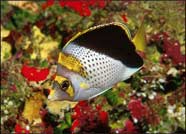
The yellow-crowned butterflyfish (Chaetodon flavocoronatus) is listed on the Red list as Vulnerable. This species is known only from Guam in the western Pacific Ocean (Photo: T. Allen)
|
Red list species - a species identified as 'Extinct', 'Extinct in the wild', 'Critically endangered', 'Endangered', 'Vulnerable', 'Lower risk', 'Data deficient' or 'Not evaluated' according to criteria laid down in the IUCN Red List Categories (International Union for the Conservation of Nature and Natural Resources, 1994) |
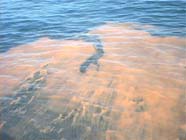
Image of red tide taken from the NOAA vessel Ron Brown, April 5, 2001 during the Aerosols Characterization Experiments (see http://www.ogp.noaa.gov/ace-asia/index.htm.) (Photo: NOAA)
|
red tide - discoloration of surface waters, most frequently in coastal areas, caused by large concentrations of microorganisms, such as algae or cyanobacteria |
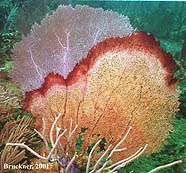
Red-band disease on a sea fan. (Photo: Dr. A. Bruckner)
|
red-band disease - a disease of corals manifested by a narrow band of filamentous cyanobacteria that advances slowly across the surface of a coral, killing tissue as it progresses. The band is reddish to maroon in color |
Redfield ratio - the molecular ratio of carbon, nitrogen and phosphorus in phytoplankton. The stoichiometric ratio is C:N:P = 106:16:1; also called "Redfield stoichiometry" |
redox potential (Eh) - a measure of a systems capacity to oxidize material; the energy gained by transferring 1 mole of electrons from an oxidant to H2. It is measured in volts relative to a hydrogen electrode which is at zero |
reductionism - a hypothesis that all complex systems can be completely understood in terms of their components; as opposed to holism |
reef - a ridge of rocks, sand, or coral that rises to or near the surface of a body of water; to partially lower a sail so that it is not as large. This helps prevent too much sail from being in use when the wind gets stronger |
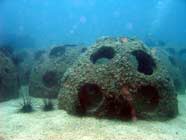
Reef balls at Royal Pahang Reef, Malaysia (Photo: Debby Ng)
|
reef ball - an artificial reef module made from concrete poured into a fiberglass mold |
reef base - the area below the consolidated slope extending up to 1 km but no deeper than 50 m. A synonym of talus slope |
reef block - a large, isolated rock section that has been displaced from the reef platform, reef margin, reef front zones or the non-calcium carbonate bedrock, usually resulting from storm waves |
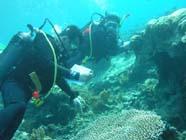
Reef Check divers surveying an Indonesian coral reef. (Photo: Reef Check)
|
Reef Check - a volunteer, community-based monitoring protocol designed to measure the health of coral reefs on a global scale. Reef Check is active in over 60 countries and territories throughout the tropics |
reef complex - the entire reef structure, including reef surface lagoon deposits and off-reef deposits |
Reef Condition Monitoring Program (RECON) - the Ocean Conservancy’s RECON Program is a low-tech, rapid monitoring protocol for assessing the health of coral reef ecosystems at selected survey sites in the tropical Western Atlantic (Wider Caribbean region). RECON trains volunteer recreational divers to observe and record valuable information about current conditions at selected coral reefs in Florida, the Bahamas, Colombia (San Andres & Old Province), Puerto Rico, and the US Virgin Islands |
reef crest - the sharp break in slope at seaward margin or edge of reef flat |
Reef Environmental Education Foundation (REEF) - REEF is a grass-roots, non-profit organization of recreational divers who regularly conduct fish biodiversity and abundance surveys during their dives |
reef fish - a species of fish found around coral reefs and artificial reefs |
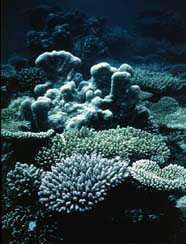
Reef flat, Palau Archipelago, Micronesia, containing various species of branching coral (Acropora). (Photo: Jerry Wellington)
|
reef flat - the shallow area between the shoreline intertidal zone and the reef crest of a fringing reef |
reef front - a synonym of reef slope |
reef manager - an individual linked to the government, local community, non-government organizations, or universities who have formal, informal, traditional, or legislated responsibility to govern uses of a coral reef ecosystem |
reef mining - the large-scale removal of living reef corals and fossilized limestone from shallow reef environments for domestic use as building materials, lime production and aggregate |
reef mound - a structure that lacks reef characteristics, such as diversification and domination stages |
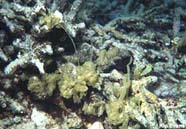
Coral reef rubble from storm damage. (Photo: Kip Evans)
|
reef rubble - dead, unstable coral pieces often colonized with macroalgae. This habitat often occurs landward of well-developed reef formations in the reef crest or back reef zone |
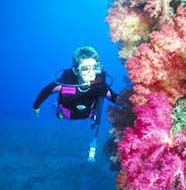
Reef slope covered with live corals.
|
reef slope - the portion of a reef seaward of reef crest |
reef system - a cluster of reefs |
reef top - the area comprising the reef flat and reef crest |
reef-boring alga - species of green (Ostreobium) and blue-green algae (Entophysalis, Hyella, and Mastigocoleus) that bore into and inhabit coral reefs, often causing erosion; some of these same algae also bore into vacant mollusk shells |
ReefBase - ReefBase is a global online information system (www.reefbase.org) on coral reefs. It provides information services to coral reef professionals involved in management, research, monitoring, conservation and education. ReefBase's online geographic information system (GIS) allows the display of coral reef related data and information on interactive maps. One can zoom in to a particular area of interest, switch various data layers on and off, and save or bookmark the map for later viewing, printing or use in presentations/documents |
REEFER - an apparatus used to quantify habitat heterogeneity (habitat complexity). It consists of a frame of selected area, e.g. two square meters, containing vertical, free moving PVC-poles every X-distance (e.g. every 10 cm) over its entire width. In use, a diver lowers the REEFER until all the poles touch the benthic substrate. Keeping the frame horizontal, a second diver records the height that each of the poles extends above the frame. Height differences between consecutive poles are compared to estimate the surface profile in each section of sampled reef . For vertical reef walls, a variation to the REEFER, the VEEFER may be used |
referral - in taxonomy, the transfer of a subordinate taxon from one taxon to another, e.g., species removed from one genus and referred to another |
reflexed - bent or turned backwards |
refractometer - an instrument for measuring radiation energy |
refugium - an area that remains unchanged while areas surrounding it change markedly; hence the area serves as a refuge for species requiring specific habitats |
regeneration - the reproduction or reconstitution of a lost or damaged organ or part through formation of new tissues |
regime - a regular pattern of occurrence or action |
regional continuity - in genetics, the appearance of similar traits within a geographic region that remain over a long period of time |
regolith - the layer of loose rock, resting on the bedrock, that constitutes the surface of most land areas |
regression - a statistical technique used to establish the relationship of a dependent variable and one or more independent variables |
regression analysis - a statistical technique applied to data to determine the degree of correlation of a dependent variable with one or more independent variables, in other words, to see if there is a strong or weak cause and effect relationship between things; a statistical process for fitting a line through a set of data points. It gives the intercept and slope(s) of the “best fitting” line. It tells how much one variable (the dependent variable) will change when other variables (the independent variables) change |

An example scatter plot data set with a regression line fit to the data.
|
regression line - a line fit to a set of data points (scatterplot) using least-squares regression; a graph of the mathematical relationship between two variables |

Regulators have two stages: a first stage that attaches to the scuba tank, and a second stage that has a mouthpiece.
|
regulator - a regulator is a piece of scuba equipment that reduces the high pressure of air in a scuba air tank to a pressure level that is usable by the diver. It delivers air to the diver only during inhalation. The modern scuba regulator is a very simple and reliable device with only a few moving parts. Regulators have two stages: a first stage that attaches to the scuba tank, and a second stage that has a mouthpiece. Air under high-pressure from the scuba tank is reduced sequentially in each stage. The first stage reduces the high tank pressure to an intermediate pressure of 100 to 150 psi above the surrounding water pressure. The second stage reduces the intermediate pressure to that needed for comfortable breathing |
regulatory gene - a gene that acts to control the protein-synthesizing activity of other genes; also called a 'regulator gene' |
rehabilitation - the recovery of specific ecosystem components in a degraded ecosystem or habitat |
reintroduction - introducing a native species back into its original habitat |
reject - in taxonomy, to set aside the name of a taxon in favor of another name |
rejected name - in taxonomy, a name which, under the provisions of the International Code of Zoological Nomenclature, cannot be used as a valid name and which is set aside in favor of another name |
relational database - a method of structuring data as collections of tables that are logically associated to each other by shared attributes. Any data element can be found in a relation by knowing the name of the table, the attribute (column) name, and the value of the primary key |
relative frequency - the number of items of a certain type divided by the number of all the numbers being considered |
releaser pheromone - a chemical produced by one organism that triggers an immediate behavior in another organism |
relict - a persistent remnant of an otherwise extinct taxon; a biological or geological feature that has survived in a considerably changed environment |
relief - the difference in elevation between the high and low points of a land surface; changes in terrain; elevations or depressions in the land |
relief map - a contour map: a map having contour lines through points of equal elevation |
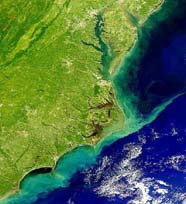
This remote sensing (SeaWiFS) image shows sediment stirred up along the North Carolina coast by Hurricane Floyd, September 1999.
|
remote sensing - the collection of information about an object or event without being in physical contact with the object or event. Remote sensing is restricted to methods that record the electromagnetic radiation reflected or radiated from an object, which excludes magnetic and gravity surveys that record force fields |
remote sensing tool - an instrument used in remote sensing often combined with a geographic information system to provide synoptic and objective views and data of the environment |
remotely operated vehicle (ROV) - an unmanned underwater vehicle remotely controlled from a vessel or an offshore platform. It is equipped with manipulator arms that enable it to perform simple operations |
renaturation - the conversion of denatured protein or DNA to its native configuration. This is rare for proteins. However, if DNA is denatured by heating, the two strands separate. If the heat-denatured DNA is then cooled slowly, the double stranded helix reforms |
renewable resource - a resource or substance that can be replenished through natural or artificial means |
reniform - kidney or bean-shaped |
repetitive dive - any dive within a certain time frame after a previous dive. Some dive tables consider any dive within 12 hours of a previous dive as repetitive |
replacement name - in taxonomy, a new taxonomic name expressly proposed for an already established one |
replication - reproduction or duplication; in genetics, the synthesis of duplex (double-stranded) DNA by copying from a single-stranded template, i.e., the synthesis of an informationally identical macromolecule from a template molecule |
reporter gene - a gene that researchers attach to another they wish to study |
repressor - a protein that binds to an operator adjacent to a structural gene, inhibiting transcription of that gene |
repressor gene - a gene that prevents a nonallele from being transcribed |
reproductive guild - a group of unrelated fishes with a similar form of reproduction |
reproductive isolating mechanism - a mechanism that prevents reproduction from occurring between two populations. Pre-zygotic reproductive isolating mechanisms (which take effect before fertilization) include environmental, temporal, behavioral, mechanical, and physiological barriers that prevent individuals of different populations from producing viable progeny. Post-zygotic reproductive isolating mechanisms (which take effect after fertilization) include gamete incompatibility, hybrid inviability, and hybrid sterility |
reproductive isolation - a species is an interbreeding natural population that is reproductively isolated from other such groups. Species are usually separated by discontinuities, which constitute barriers that prevent, or at least inhibit, an interspecific gene flow and gene exchange. Establishment of reproductive isolation is essential for development of a new species |
reproductive strategy - the way in which a species allocates or budgets energy to produce viable offspring. Energy is diverted into actual offspring and into parental care. The energy may be invested a multitude of offspring that receive little or no parental care (r-strategy), or invested in a few, large offspring that require considerable parental care (K-strategy). Although some organisms are primarily r- or K-strategists, the majority of organisms fall between these two extremes and may display traits considered characteristic of both ends of the r/K spectrum |
resident - a permanent, non-migratory inhabitant |
residual nitrogen time (RNT) - a theoretical mathematical representation of the amount of nitrogen absorbed in body tissues after a scuba dive. It is expressed on dive tables in minutes which are added to the no-decompression limit for a repetitive dive, i.e., the time it would take to off-gas any extra nitrogen remaining after a dive |
resilience - the ability of a community or ecosystem to recover from disturbances and maintain a desired condition of diversity, integrity, and ecological processes |
resiliency - the ability of a population, community or ecosystem to return to a healthy state after experiencing damaging events which do not exceed its recovery capabilities, e.g. recovery of a coral reef after a bleaching event |
resilient - resumes the original shape after deformation; elastic |
resolution - the ability to distinguish closely spaced objects on an image or photograph. It is commonly expressed as the spacing, in line-pairs per unit distance, of the most closely spaced lines that can be distinguished |
resonance - literally means “to vibrate with”. The tendency of a system to absorb more oscillatory energy when the frequency of the oscillations matches the system's natural frequency of vibration (its resonant frequency) than it does at other frequencies. In physics, resonance occurs when two systems are vibrating within the same frequency range. When resonant waves meet, they create order. In contrast, when two waves vibrating at different frequencies meet, they create chaos or dissonance; reinforcement and intensification of sound by vibrations |
resonator - a structure that fills with sound and acts as a natural amplifier |
resource partitioning - the dividing of scarce resources in order that species with similar requirements can use the resources in different ways, in different places, and at different times; the division of resources such that a few dominant species exploit most of the available resources while other species divide the remainder. This helps explain why a few species are abundant in a community while others are represented by only a few individuals |
respiration - a biochemical process by which living organisms take up oxygen from the environment and consume organic matter, releasing both carbon dioxide and heat energy |
respiratory tree - a respiratory organ of sea cucumbers (Holothuroidea-Echinodermata) |
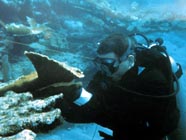
A diver prepares to reattach an elkhorn coral fragment in a Mona Island, PR, reef as part of restoration work performed after the 1997 grounding of the Fortuna Reefer. (Photo: Erik Zobrist, NOAA Restoration Center)
|
restoration - the return of an ecosystem or habitat to its original community structure, natural complement of species, and natural function |
restoration ecology - activities undertaken by humans to repair ecological damage, such as establishing vegetation on degraded habitat, increasing the populations of endangered species, and decreasing the threatened area of an ecosystem |
restoration monitoring - the systematic collection and analysis of data that provides information useful for measuring restoration project performance at a variety of scales (locally, regionally, and nationally), determining when modification of efforts is necessary, and building long-term public support for habitat protection and restoration |
restriction endonuclease - a class of endonucleases that cleaves DNA after recognizing a specific sequence |
restriction enzyme - an enzyme that cleaves double-stranded DNA; an endonuclease that recognizes specific nucleotide sequences and cleaves DNA at these highly specific locations. In genetic engineering, new genes can be inserted into these gaps |
restriction fragment length polymorphism (RFLP) - variation in DNA sequence between individuals that is detectable by variation in the length of DNA fragments generated by digestion with restriction endonucleases |
restriction fragment - a fragment of DNA produced by cleaving (digesting, cutting) a DNA molecule with one or more restriction endonucleases |
restriction map - a genetic map of a DNA sequence showing the restriction sites (where a restriction enzyme cleaves DNA) of one or more restriction enzymes |
restriction site - a sequence of DNA that is recognized by an endonuclease (a protein that cuts DNA) as a site at which the DNA is to be cut; also called "restriction enzyme cutting site" |
reticulate - resembling or forming a network |
reticulate evolution - the union of different lineages of a clade by hybridization |
retractable - capable of being drawn or pulled back |
retractile polyp - a polyp in which the anthocodium can invert into the anthostele or into the coenenchyme |
retractor - a muscle that withdraws an eversible or protrusible body part |
retronym - a word or phrase created because an existing term that was once used alone needs to be distinguished from a term referring to a new development; a modification of an existing word occasioned by a discovery or a new concept; as Atlantic herring in contrast to Pacific herring, acoustic guitar in contrast to electric guitar or analog watch in contrast to digital watch |
retrorse - bent or turned backward or downward |
retrose - turned backwards |
retrovirus - a virus that contains the enzyme, reverse transcriptase. This enzyme converts the viral RNA into double-stranded DNA copies of their genome, (by using reverse transcription), which can combine with the DNA of the host cell and produce more viral particles. Many naturally occurring cancers of vertebrates are caused by retroviruses |
reverse evolution - evolution which occurs when DNA returns to an ancestral form. Reverse evolution has been demonstrated in laboratory experiments at the University of Utah, in which a half billion year-old gene was reconstructed by combining key portions of two modern mouse genes that descended from the archaic gene; also called "retrograde evolution" |
reverse transcriptase - an enzyme that is able to synthesize DNA from information in RNA. It requires an RNA template and a DNA or RNA primer |
reverse transcription - the synthesis of DNA on a template of RNA, accomplished by the enzyme, reverse transcriptase |
revision - in taxonomy, a critical re-appraisal of a taxon |
rheokinesis - movement in relation to water currents |
rheotaxis - orientation to water currents. An animal may face into the current (positive rheotaxis) or face downstream of the current (negative rheotaxis) |
rhinophoral sheath - in sea slugs, the upstanding flange from the antero-lateral part of the mantle into which a rhinophore can be contracted |
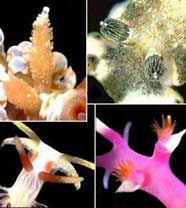
The rhinophores on this sea slug function as chemosensory organs (Photo: Bill Rudman)
|
rhinophore - paired, tentacle-like chemical sensory apparatus found on the anterior end or "head" of nudibranchs. They act as olfactory/taste organs. To protect them from damage, most are able to be withdrawn into a pocket beneath the skin. Often there is a raised collar or sheath around each pocket which can be clamped shut when the sea slug is disturbed |
rhizobenthos - organisms rooted in the substratum |
rhizome - a horizontal stem |
rho - in molecular genetics, there are a number of proteins involved in termination of transcription (the process whereby RNA is synthesized from a DNA template), particularly a protein called rho, which is involved in assisting RNA polymerase to terminate transcription at certain (rho-dependent) sites in the bacterium, Escherichia coli. The mechanism by which rho terminates transcription is not understood, and there are as yet no apparent sequence similarities in these rho-dependent termination regions |
rho-dependent terminator - a DNA sequence signaling the termination of transcription. Termination requires the presence of the rho protein |
rho-independent terminator - a DNA sequence signaling the termination of transcription.The rho protein is not required for termination |
rhomboid - diamond-shaped |
rhopalium - one of the sensory receptors in some jellyfish (Scyphozoa and Cubozoa), located on the margin of the bell. Rhopalia contain statocysts for equilibrium, and ocelli, which are photosensitive cells which allow the animal to respond to light stimulation |
ribbed - describes a surface with a series of ridges |
ribbon reef - a large offshore linear reef, seaward of a fringing reef, which is linear but does not form a barrier to the land. A synonym of shelf-edge reef and sill reef |

A nitrogenous base is combined with a five-carbon sugar, either ribose (for RNA) or deoxyribose (for DNA). The arrows point to the single structural difference between ribose and deoxyribose. (Graphic: San Diego State University)
|
ribose - a monosaccharide containing five carbon atoms per sugar molecule, C5H10O5. Ribose is a major component of ribonucleic acid (RNA) |
ribosome - a cellular organelle composed of specific ribosomal RNA (rRNA) and proteins that are responsible for the translation of messenger (mRNA) into protein synthesis |
Richter scale - a logarithmic scale that measures the amount of energy released during an earthquake on the basis of the amplitude of the highest peak recorded on a seismogram. Each unit increase in the Richter scale represents a 10-fold increase in the amplitude recorded on the seismogram and a 30-fold increase in energy released by the earthquake |
ridge - a long, narrow, continuous elevation of the sea floor covered with shallow water which may support unconsolidated sediments, rocks, or shallow reefs |
Riley's Hump - a geological feature known as a "give-up" reef located in the northern portion of the Tortugas South Ecological Reserve. A "give-up" reef is a reef which is not growing fast enough to keep up with sea level rise. Riley's Hump has long been known to local fishermen who have recognized it as an important spawning area for a variety of commercially important reef fish species, such as mutton snapper. Riley's Hump marks the western extent of the south Florida reef tract. Live-bottom communities (<1 m relief) consist of sponges, heavily epiphytized, flexible corals, and brown algae with lesser stony head corals situated on tabular cemented crusts and submarine ledges |
ring canal - a part of the water vascular system of echinoderms. Specifically, a circumoral ring around the esophogus with connecting radial canals each leading to an ambulacrum .It connects to the madreporite via the stone canal; also, the part of the distributive portion of the digestive system of scyphozoan medusae that is located in the margin of the bell. The ring canal communicates with the radial and adradial canals |
ring species - a gene flow situation in which two reproductively isolated populations occupying the same region are genetically connected by a geographic ring of populations that can interbreed |
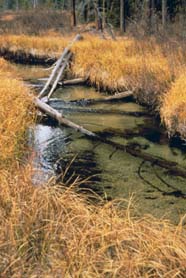
This healthy riparian habitat includes undercut banks, woody debris in the water, and a clean stream bottom.
|
riparian - having to do with living or being located on the edges or banks of streams or rivers |
riprap - large pieces of rock (usually 6 to 30 inches in diameter) which have undergone only primary crushing and sizing, or larger, uncrushed pieces. Riprap is used to stabilize slopes and shorelines and construct erosion-control structures |

The yawn of the baboon is an example of ritualized behavior. (Photo: Gaping Maws (www.animalyawns.com))
|
ritualized behavior - a behavior that once served its own purpose but has come to act as a signal about that purpose. For example, agonistic behaviors that substitute for physical contact and fighting, such as the erection of fins by fishes during displays, the yawn of baboons, the baring of teeth in dogs and wolves, the raising of fur in cats, and birds raising their feathers |
riverine - associated with a river and the area adjacent to it; includes all wetlands and deepwater habitats contained within a stream channel |
riverine environment - an environment created along permanent and semi-permanent streams because of the increase in soil moisture |
riverine habitat - a habitat occurring along a river |
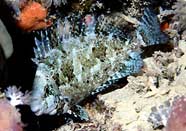
the rivulated parrotfish, Scarus rivulatus, has a pattern of irregular streaks on its head (Photo: Dr. John E. Randall)
|
rivulated - marked by irregular streaks |
RNA (Ribonucleic acid) - a single-stranded nucleic acid found in the nucleus and cytoplasm of a cell. It is a polymer of the sugar ribose, phosphate, purine and pyrimidine bases. RNA is very similar to DNA, but substitutes the nucleotide, uracil, for thymine. It acts as a "middle-man", converting genetic information from DNA to proteins. There are three types of RNA: mRNA (messenger RNA), which contains the specific sequence of nucleotides necessary to dictate amino acid sequence in proteins; trNA (transfer RNA), which serves as the "adaptor" to position the appropriate amino acid next to a growing polypeptide chain during protein synthesis; and rRNA (ribosomal RNA), which is the RNA component of ribosomes. In some viruses, RNA is the genetic material |
RNA polymerase - an enzyme that catalyzes the bonding reaction between nucleotides of DNA and RNA. Organisms use RNA polymerase to accelerate the process of copying DNA strands during cell reproduction |
RNAi (RNA-mediated interference) - a technology based on the silencing of specific genes by double stranded RNA (dsRNA). RNAi has great potential for treating many diseases, including ocular, viral diseases and cancers by silencing RNA messages, thereby preventing the production of disease causing proteins |
robust - a large or heavily built body or body part |
rock - a naturally occurring aggregate of minerals and/or mineraloids. Rocks are classified by mineral and chemical composition; the texture of the constituent particles; and also by the processes that formed them. Rocks are thus separated into igneous, sedimentary, and metamorphic rocks |
Rock Islands - a small group, approximately 250 in number, of limestone or coral uprises, ancient relics of coral reefs that surfaced to form Islands, in Palau's Southern Lagoon between the islands of Koror and Peleliu. The Rock Islands are for the most part uninhabited, and are famous for their beaches, blue lagoons and the mushroom-like shapes . The Rock Islands and the surrounding reefs make up Palau's popular tourist sites such as Blue Corner, Blue hole, and the famed Jellyfish Lake, one of 70 Marine lakes in the Rock Islands that provides habitat for millions of "stingless" jellyfish |
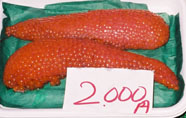
Salmon roe marked for sale at a seafood market in Japan. (Photo: NOAA)
|
roe - fish eggs or egg-filled ovary; the egg mass or spawn of certain crustaceans, such as lobsters |
roentgen - unit of x-radiation or gamma radiation |

An albatross rookery at the Midway Atoll National Wildlife Refuge. (Photo: USFWS/Susan Middleton)
|
rookery - a breeding ground for gregarious birds or mammals |
Rose Atoll National Wildlife Refuge - Rose Atoll National Wildlife Refuge is located about 2,500 miles south of Hawaii, at the east end of the Samoan archipelago, 180 miles east of Pago Pago, American Samoa. It is the smallest atoll in the world with about 20 acres of land and 1,600 acres of lagoon. The square-shaped atoll protects two small, emergent islands. Rose Island, the larger of the two, is an important nesting area for the threatened green sea turtle and endangered Hawksbill sea turtle. It is within the U.S. territory of American Samoa |
rosette - rose-shaped in appearance; arranged in a fashion resembling a rose flower |
rostral - towards or relating to the snout or rostrum |
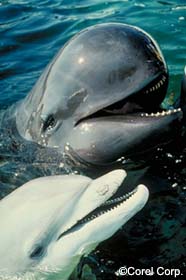
Most dolphins have an elongated beak called a rostrum. (Photo: Copyright Corel Corp.)
|
rostrum - an elongate or extended snout |
rotenone - a very potent general use pesticide found in the roots and stems of several tropical plants. Jewel vine (Derris spp.), Lacepod (Lonchocarpus spp.), and hoary pea (Tephrosia spp.) are the more common plants from which rotenone is derived. It used in some countries to kill predatory fishes prior to introducing parent fish for natural spawning or newly hatched fry. As an effective fish biocide, rotenone is also used for collecting fish specimens, and in some areas for fishing, where it is added to the water and the dead and dying fishes are collected as they float to the surface. In fishes, rotenone impedes circulation to the gills, causing asphixiation |
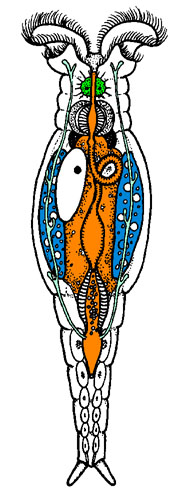
Internal anatomy of a rotifer. The major systems have been highlighted in color. (Graphic: Livingstone, BIODIDAC)
|
rotifer - rotifers are small invertebrates in the Phylum Rotifera.They range in size from 100 to 2500 microns, with approximately 2000 described species. Rotifers are found in aquatic and semi-aquatic habitats, but are predominantly freshwater inhabitants. Most species are free-living herbivores, bacteriovores or predators, and possess a ciliated, wheel-like organ for feeding and locomotion. Rotifers move by swimming or crawling. Some sessile species are permanently attached to freshwater plants |
rRNA (ribosomal RNA) - any one of several large RNA molecules that are structural and functional components of ribosomes |
rubbery - a tough, resilient mass |
rubble zone - the shallowest part of a reef crest landward of the palmata zone. It consists of broken pieces of coral washed back by storms |
rudimentary - a very elementary or early stage of development; not fully developed and not functional; organs in the early stage of development may be rudimentary |
rugose - having a rough or ridged surface |
rugose corals - an extinct group of non-scleractinian corals |
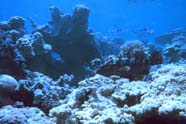
A coral reef with a high degree of rugosity.
|
rugosity - an important coral reef parameter that describes the amount of "wrinkling" or roughness of the reef profile. It is an index of substrate complexity. Areas of high complexity are likely to provide more cover for reef fishes and more places of attachment for algae, corals and various sessile invertebrates |
run aground - to take a boat into water that is too shallow for it to float in, i.e., the bottom of the boat is resting on the ground |
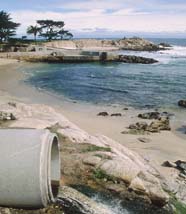
Urban runoff or 'storm drain pollution' is one of the leading causes of water pollution in this country. (Photo: NOAA/NOS/Monterey Bay National Marine Sanctuary)
|
runoff - water that has been on land and moves seaward as a result of rain, flooding, irrigation or flushing . Runoff is frequently high in nutrients and suspended sediments, as well as toxicants |
rural area - an area in which most residents depend on agriculture or the harvesting of natural resources for their livelihood |
russet - reddish brown color |

Rusticle hanging from the stern section of the RMS Titanic showing secondary growths during maturation. (Photo: Lori Johnston)
|
rusticle - a structure consisting of up to 35% iron compounds (iron oxides, iron carbonates, and iron hydroxides) that forms under water when wrought iron rusts. In appearance, it resembles an icicle or stalactite. The remainder of the structure is a complex community of symbiotic or mutualistic microorganisms, including bacteria and fungi, that use the rusting metal as a source of energy, collectively producing the mineral compounds as waste products and hence forming the rusticle. Structurally, the rusticle contains channels to allow water to flow through.They are very delicate, and easily disintegrate into a fine powder if disturbed. The outer surface of a rusticle is red in appearance while the core is bright orange |
rutherford - unit of radioactive decay equal to 1 million disintegrations per second |
|
|
|
|

